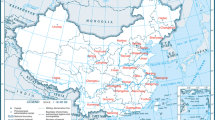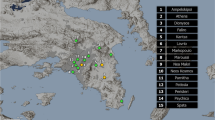Abstract
The newly developed Universal Thermal Climate Index (UTCI), along with the physiological equivalent temperature (PET), the humidex (HX) and the wind chill index (WC), was calculated in Quebec City, Canada, a city with a strong seasonal climatic variability, over a 1-year period. The objective of this study is twofold: evaluate the operational benefits of implementing the UTCI for a climate monitoring program of public comfort and health awareness as opposed to relying on traditional and simple indices, and determine whether thermal comfort monitoring specific to dense urban neighborhoods is necessary to adequately fulfill the goals of the program. In order to do so, an analysis is performed to evaluate each of these indices’ sensitivity to the meteorological variables that regulate them in different environments. Overall, the UTCI was found to be slightly more sensitive to mean radiant temperature, moderately more sensitive to humidity and much more sensitive to wind speed than the PET. This dynamic changed slightly depending on the environment and the season. In hot weather, the PET was found to be more sensitive to mean radiant temperature and therefore reached high values that could potentially be hazardous more frequently than the UTCI and the HX. In turn, the UTCI’s stronger sensitivity to wind speed makes it a superior index to identify potentially hazardous weather in winter compared to the PET and the WC. Adopting the UTCI broadly would be an improvement over the traditionally popular HX and WC indices. The urban environment produced favorable conditions to sustain heat stress conditions, where the indices reached high values more frequently there than in suburban locations, which advocates for weather monitoring specific to denser urban areas.










Similar content being viewed by others
References
Alduchov OA, Eskridge RE (1996) Improved Magnus form approximation of saturation vapor pressure. J Appl Meteorol 35:601–609
Bergeron O (2014) Caractérisation de la variabilité spatiale et temporelle de la température de l’air ambiant sur un territoire urbain : étude du cas de la ville de Québec. Ministère du Développement durable, de l’Environnement et de la Lutte contre les changements climatiques, Quebec City
Błażejczyk K, Epstein Y, Jendritzky G, Staiger H, Tinz B (2012) Comparison of UTCI to selected thermal indices. Int J Biometeorol 56:515–535
Błażejczyk K, Jendritzky G, Bröde P, Fiala D, Havenith G, Epstein Y, Psikuta A, Kampmann B (2013) An introduction to the Universal Thermal Climate Index (UTCI). Geogr Pol 86:5–10
Bleta A, Nastos PT, Matzarakis A (2014) Assessment of bioclimatic conditions on Crete Island, Greece. Reg Environ Chang 14:1967–1981
Bröde P, Krüger EL, Rossi FA, Fiala D (2012a) Predicting urban outdoor thermal comfort by the Universal Thermal Climate Index (UTCI)—a case study in southern Brazil. Int J Biometeorol 56:471–480
Bröde P, Fiala D, Błażejczyk K, Holmér I, Jendritzky G, Kampmann B, Tinz B, Havenith G (2012b) Deriving the operational procedure for the Universal Thermal Climate Index (UTCI). Int J Biometeorol 56:481–494
Budd GM (2008) Wet-bulb globe temperature (WBGT)—its history and its limitations. J Sci Med Sport 11:20–32
Burkard K, Schneider A, Breitner S, Khan MH, Krämer A, Endlicher W (2011) The effect of atmospheric thermal conditions and urban thermal pollution on all-cause and cardiovascular mortality in Bangladesh. Environ Pollut 159:2035–2043
Cohen P, Potchter O, Matzarakis A (2012) Daily and seasonal climatic conditions of green urban open spaces in the Mediterranean climate and their impact on human comfort. Build Environ 51:285–295
Environment Canada (2014). Spring and summer weather hazards. https://www.ec.gc.ca/meteo-weather/default.asp?lang=En&n=6C5D4990-1. Accessed 27 March 2015
Environment Canada (2015) Wind chill—the chilling facts. http://www.ec.gc.ca/meteo-weather/default.asp?lang=En&n=5FBF816A-1. Accesses 27 March 2015
Epstein Y, Moran DS (2006) Thermal comfort and the heat stress indices. Ind Health 44:388–398
Fanger PO (1970) Thermal comfort. Danish Technical, Copenhagen
Fiala D, Lomas KJ, Stohrer M (1999) A computer model for human thermoregulation for a wide range of environmental conditions: the passive system. J Appl Physiol 87:1957–1972
Fiala D, Lomas KJ, Stohrer M (2001) Computer prediction of human thermoregulatory and temperature responses to a wide range of environmental conditions. Int J Biometeorol 45:143–159
Fiala D, Havenith G, Bröde P, Kampmann B, Jendritzky G (2012) UTCI-Fiala multi-node model of human heat transfer and temperature regulation. Int J Biometeorol 56:429–441
Gagge AP, Stolwijk JAJ, Nishi Y (1971) An effective temperature scale based on a simple model of human physiological regulatory response. ASHRAE Trans 77:247–260
Gagge AP, Forbelets AP, Berglund LG (1986) A standard predictive index of human response to the thermal environment. ASHRAE Trans 92:709–729
Havenith G, Fiala D, Błażejczyk K, Richards M, Bröde P, Holmér I, Rintamaki H, Benshabat Y, Jendritzky G (2012) The UTCI-clothing model. Int J Biometeorol 56:461–470
Höppe PR (1993) Heat balance modelling. Experientia 49:741–746
Höppe P (1999) The physiological equivalent temperature—a universal index for the biometeorological assessment of the thermal environment. Int J Biometeorol 43:71–75
Humphreys MA (1994) Field studies and climate chamber experiments in thermal comfort research. In: Oseland NA, Humphreys MA (eds) Thermal comfort: past, present and future. Building Research Establishment, Watford, pp. 52–69
Jendritzky G, de Dear R, Havenith G (2012) UTCI—why another thermal index? Int J Biometeorol 56:421–428
Johansson E, Emmanuel R (2006) The influence of urban design on outdoor thermal comfort in the hot, humid city of Colombo, Sri Lanka. Int J Biometeorol 51:119–133
Kántor N, Unger J (2011) The most problematic variable in the course of human-biometeorological comfort assessment—the mean radiant temperature. Cent Eur J Geosci 3:90–100
Kántor N, Égerházi L, Unger J (2012) Subjective estimation of thermal environment in recreational urban spaces—Part 1: investigations in Szeged, Hungary. Int J Biometeorol 56:1075–1088
Krüger E, Drach P, Emmanuel R, Corbella O (2013) Assessment of daytime outdoor comfort levels in and outside the urban area of Glasgow, UK. Int J Biometeorol 57:521–533
Landsberg HE (1981) The urban climate. Academic Press, New York
Leduc R, Ferland M, Gariépy J, Jacques G, Lelièvre C, Paulin G (1980) Îlot de chaleur à Québec: cas d’été. Bound Layer Meteorol 19:471–480
Leduc R, Jacques G, Ferland M, Lelièvre C (1981) Îlot de chaleur à Québec: cas d’hiver. Bound Layer Meteorol 21:315–324
Lin TP, de Dear R, Hwang RL (2011) Effect of thermal adaptation on seasonal outdoor thermal comfort. Int J Climatol 31:302–312
Makaremi N, Salleh E, Jaafar MZ, Hoseini AG (2012) Thermal comfort conditions of shaded outdoor spaces in hot and humid climate of Malaysia. Build Environ 48:7–14
Matzarakis A, Mayer H, Iziomon MG (1999) Applications of a universal thermal index: physiological equivalent temperature. Int J Biometeorol 43:76–84
Matzarakis A, Rutz F, Mayer H (2007) Modelling radiation fluxes in simple and complex environments—application of the RayMan model. Int J Biometeorol 51:323–334
Matzarakis A, Rutz F, Mayer H (2010) Modelling radiation fluxes in simple and complex environments: basics of the RayMan model. Int J Biometeorol 54:131–139
Mayer H, Holst J, Dostal P, Imbery F, Schindler D (2008) Human thermal comfort in summer within an urban street canyon in central Europe. Meteorol Z 17:241–250
MDDELCC (2015) Normales climatiques 1981–2010. http://www.mddelcc.gouv.qc.ca/climat/normales/climat-qc.htm. Accessed 27 March 2015
Minard D, Belding HS, Kingston JR (1957) Prevention of heat casualties. J Am Med Assoc 165:1813–1818
Oliveira S, Andrade H (2007) An initial assessment of the bioclimatic comfort in an outdoor public space in Lisbon. Int J Biometeorol 52:69–84
Osczevski R, Bluestein M (2005) The new wind chill equivalent temperature chart. Bull Am Meteorol Soc 86:1453–1548
Pearlmutter D, Bitan A, Berliner P (1999) Microclimatic analysis of “compact” urban canyons in an arid zone. Atmos Environ 33:4143–4150
Peel MC, Finlayson BL, McMahon TA (2007) Updated world map of the Köppen–Geiger climate classification. Hydrol Earth Syst Sci 11:1633–1644
Santee WR, Wallace RF (2005) Comparison of weather service heat indices using a thermal model. J Therm Biol 30:65–72
Spagnolo J, de Dear R (2003) A field study of thermal comfort in outdoor and semi-outdoor environments in subtropical Sydney Australia. Build Environ 38:721–738
Steadman RG (1984) A universal scale of apparent temperature. J Clim Appl Meteorol 23:1674–1687
Steadman RG (1994) Norms of apparent temperature in Australia. Aust Meteorol Mag 43:1–16
Taylor NAS (2006) Challenges to temperature regulation when working in hot environments. Ind Health 44:331–344
Thorsson S, Honjo T, Lindberg F, Eliasson I, Lim E (2007a) Thermal comfort and outdoor activity in Japanese urban public places. Environ Behav 39:660–684
Thorsson S, Lindberg F, Eliasson I, Holmer B (2007b) Different methods for estimating the mean radiant temperature in an outdoor urban setting. Int J Climatol 27:1983–1993
Toy S, Yilmaz S (2010) Thermal sensation of people performing recreational activities in shadowy environment: a case study from Turkey. Theor Appl Climatol 101:329–343
Acknowledgments
The authors are grateful to Environment Canada for supplying the meteorological data at the Jean-Lesage and Sainte-Foy stations, and to Dr. Andreas Matzarakis for providing the RayMan software. This project was funded by the Ministère du Développement durable, de l’Environnement et de la Lutte contre les changements climatiques.
Author information
Authors and Affiliations
Corresponding author
Rights and permissions
About this article
Cite this article
Provençal, S., Bergeron, O., Leduc, R. et al. Thermal comfort in Quebec City, Canada: sensitivity analysis of the UTCI and other popular thermal comfort indices in a mid-latitude continental city. Int J Biometeorol 60, 591–603 (2016). https://doi.org/10.1007/s00484-015-1054-2
Received:
Revised:
Accepted:
Published:
Issue Date:
DOI: https://doi.org/10.1007/s00484-015-1054-2




